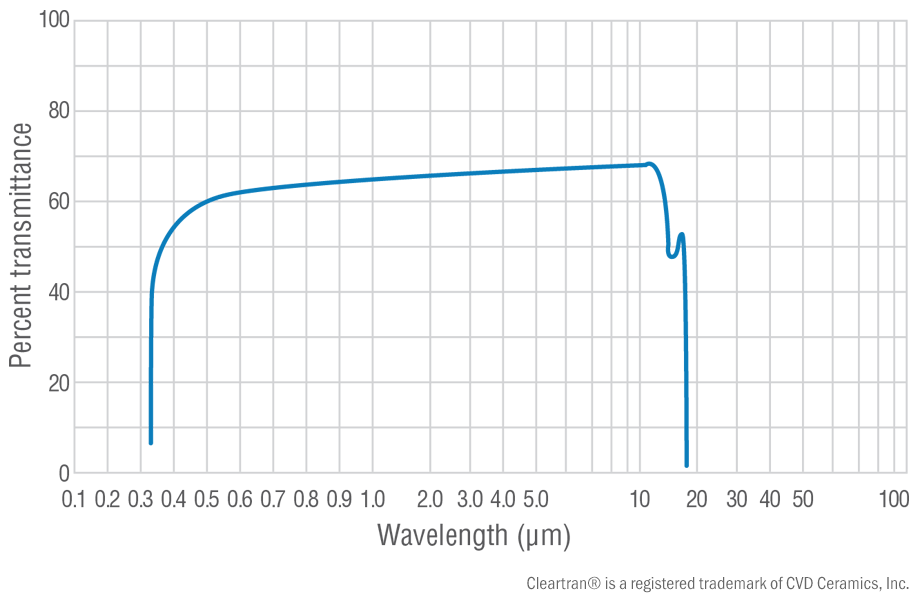Cryostat windows
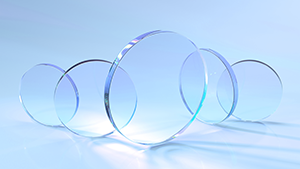
Lake Shore offers a full range of windows for transmitting light from x-rays to the THz range. Standard optical cryostats have fused silica windows installed, but most can easily be upgraded to a different window material for other applications. The following shows window materials typically used on Lake Shore cryostats and outline essential details, including whether the material is suitable for use as a cold window. Specialty materials, such as beryllium or vanadium, are available on request. Our sales engineers can help determine the best window material for the required transmission range.
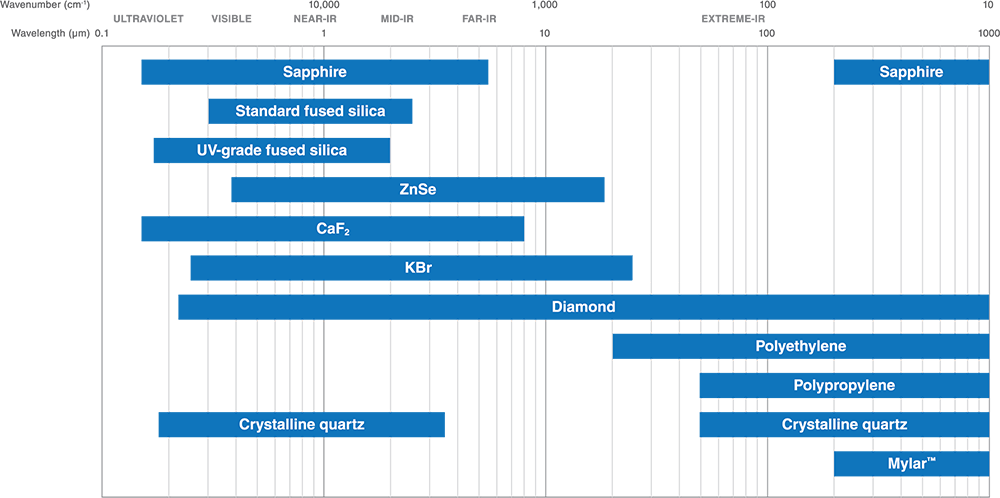
Sapphire
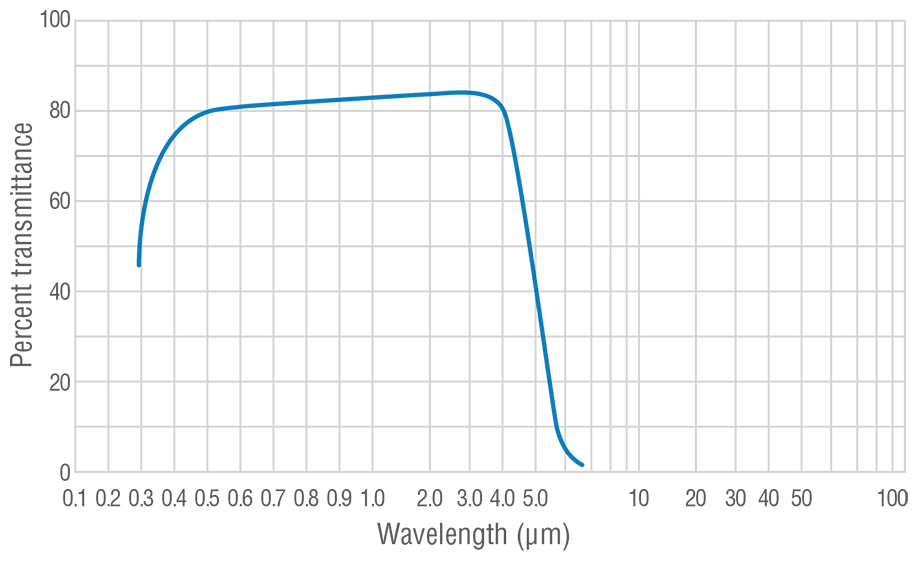 Sapphire
has a very broad transmission range, extending from ultraviolet to near-infrared. It is opaque in mid-infrared but opens up again in far-infrared. Sapphire is very strong, allowing thinner material to be used if needed, and may be used as
a cold window. Sapphire is a crystalline material, so care must be taken if the application is sensitive to birefringence.
Sapphire
has a very broad transmission range, extending from ultraviolet to near-infrared. It is opaque in mid-infrared but opens up again in far-infrared. Sapphire is very strong, allowing thinner material to be used if needed, and may be used as
a cold window. Sapphire is a crystalline material, so care must be taken if the application is sensitive to birefringence.
| Refractive index | 1.76 |
|---|---|
| Transparency range | 0.15 μm to 5.5 µm and >200 µm |
| Scratch-resistant | |
| Cold window ✔ | |
Standard fused silica
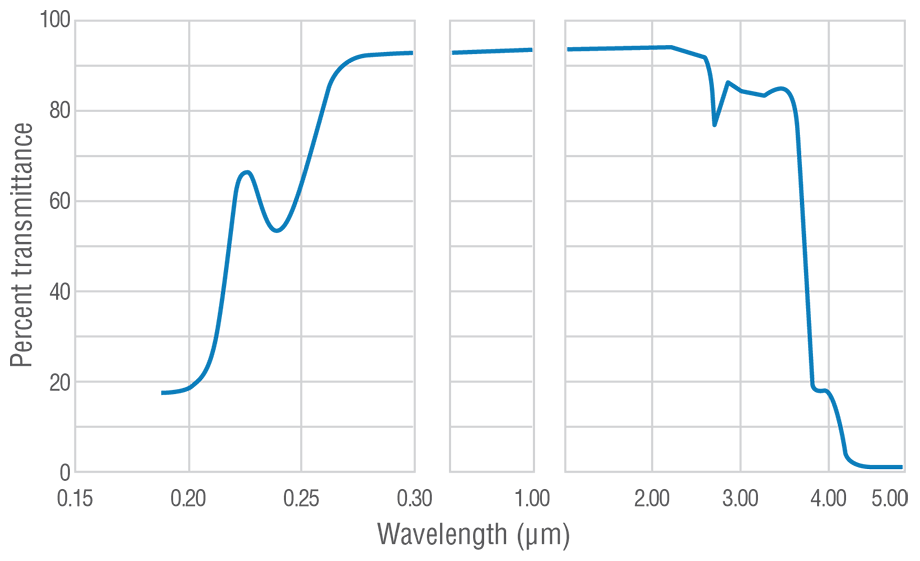 Standard fused silica is an inexpensive choice for general-purpose windows and is the material used on all standard 1.63 in clear view Environment by Janis window ports. It is easy to clean, difficult to scratch, and has a broad transmission range. It is strong enough for both room temperature and cold windows. Some fluorescence is seen in the ultraviolet, so care must be taken if the application requires transmission at shorter wavelengths.
Standard fused silica is an inexpensive choice for general-purpose windows and is the material used on all standard 1.63 in clear view Environment by Janis window ports. It is easy to clean, difficult to scratch, and has a broad transmission range. It is strong enough for both room temperature and cold windows. Some fluorescence is seen in the ultraviolet, so care must be taken if the application requires transmission at shorter wavelengths.
| Refractive index | 1.46 |
|---|---|
| Transparency range | 0.3 μm to 2.5 µm |
| Scratch-resistant | |
| Cold window ✔ | |
UV-grade fused silica
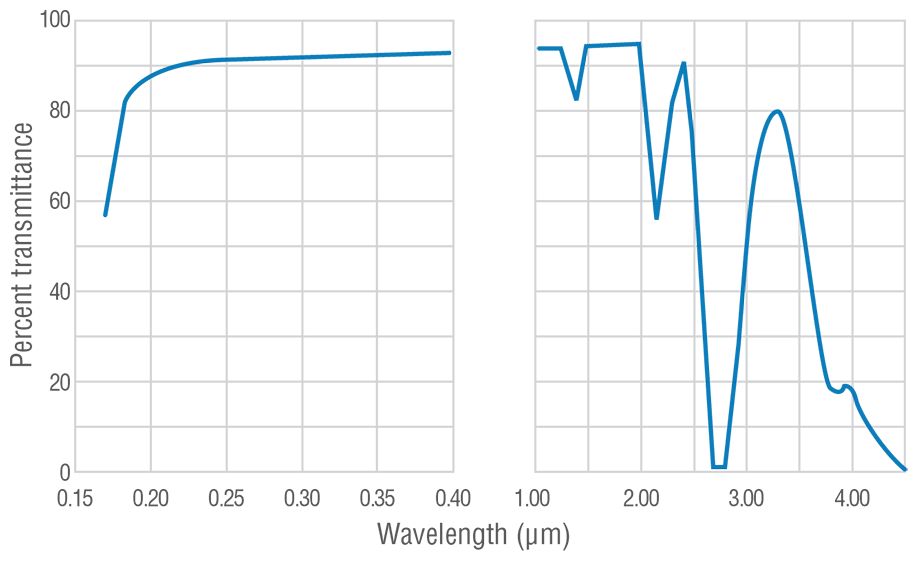 UV-grade
fused silica is a good choice for ultraviolet transmission and may be used for both room temperature and cold windows. Like the standard material, UV-grade fused silica is easy to clean and difficult to scratch. It is commonly the standard
on smaller Environment by Janis cryostats and is an option for cryostats with standard 1.63 in clear view diameter ports.
UV-grade
fused silica is a good choice for ultraviolet transmission and may be used for both room temperature and cold windows. Like the standard material, UV-grade fused silica is easy to clean and difficult to scratch. It is commonly the standard
on smaller Environment by Janis cryostats and is an option for cryostats with standard 1.63 in clear view diameter ports.
| Refractive index | 1.46 |
|---|---|
| Transparency range | 0.17 μm to 2.0 µm |
| Scratch-resistant | |
| Cold window ✔ | |
Zinc selenide (ZnSe)
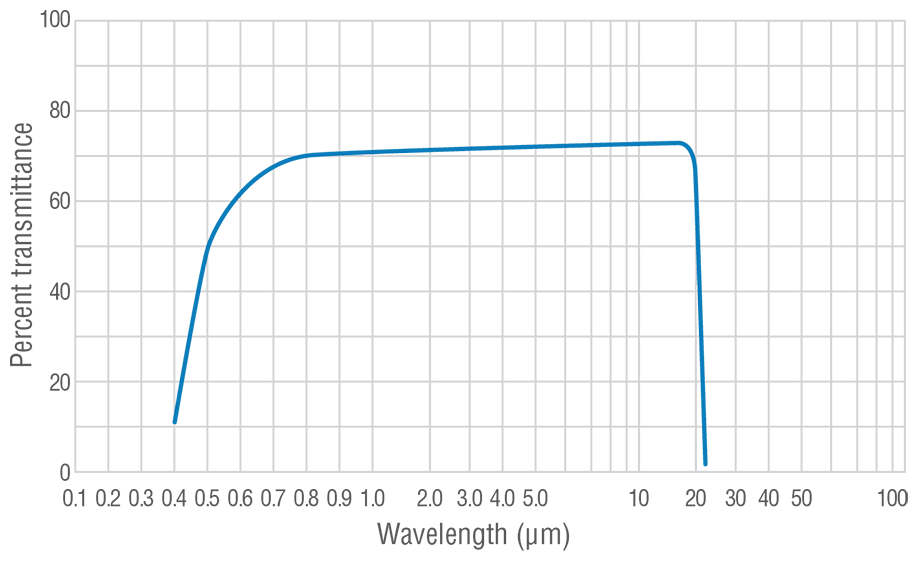 ZnSe
is a yellow material with transmission into the mid-infrared. This material is quite soft, so care must be taken when handling these windows to avoid scratching. With special strain relief mounting, ZnSe may be sealed cold. A BBAR coating
for higher transmission over a specific wavelength range is available upon request.
ZnSe
is a yellow material with transmission into the mid-infrared. This material is quite soft, so care must be taken when handling these windows to avoid scratching. With special strain relief mounting, ZnSe may be sealed cold. A BBAR coating
for higher transmission over a specific wavelength range is available upon request.
| Refractive index | 2.74 |
|---|---|
| Transparency range | 0.38 μm to 18.4 µm |
| Susceptible to scratching | |
| Cold window ✔ | |
Calcium fluoride (CaF2)
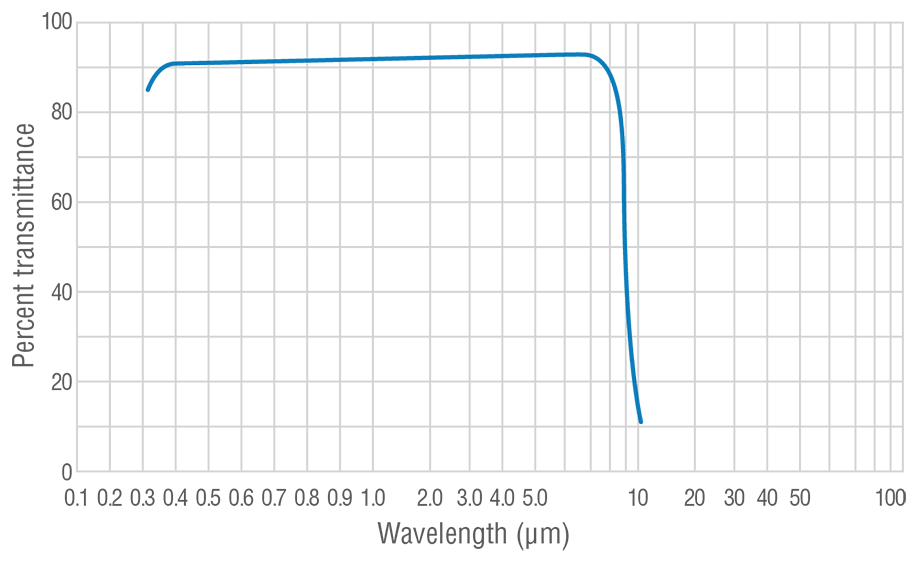 CaF2 has excellent transmission from the soft UV to the near-IR range and transmits further into IR than fused silica or sapphire. It is not as easily scratched as ZnSe but is difficult to seal cold, so it is only used as a room-temperature window.
CaF2 has excellent transmission from the soft UV to the near-IR range and transmits further into IR than fused silica or sapphire. It is not as easily scratched as ZnSe but is difficult to seal cold, so it is only used as a room-temperature window.
| Refractive index | 1.43 |
|---|---|
| Transparency range | 0.15 μm to 8.0 µm |
| Scratch resistant | |
| Cold window ✖ | |
Potassium bromide (KBr)
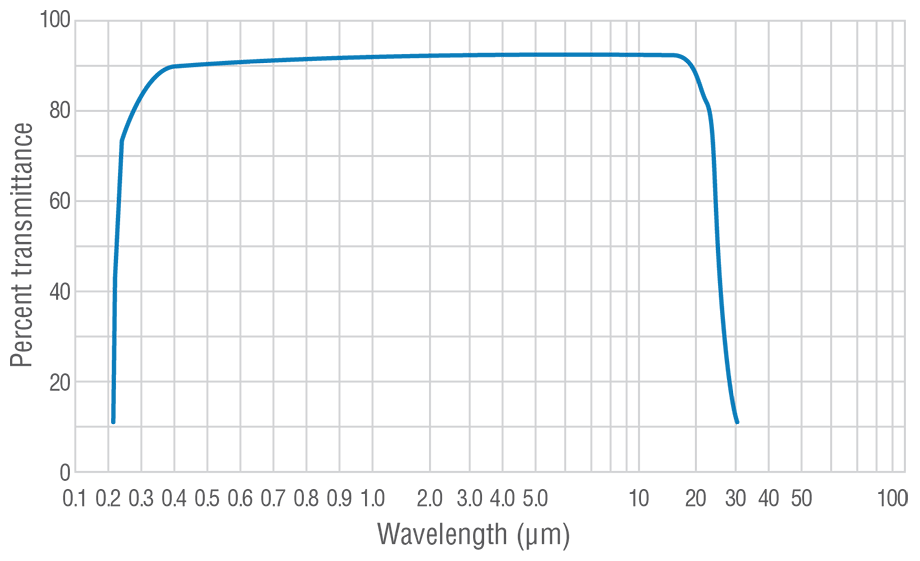 KBr
has good transmission into infrared and is useful on cryostats, including the ST-FTIR or VPF-FTIR. KBr is soft and needs to be thicker than other materials to withstand the force of vacuum, and it cannot be used as a cold window. KBr is hygroscopic, so care needs to be taken to keep it dry.
KBr
has good transmission into infrared and is useful on cryostats, including the ST-FTIR or VPF-FTIR. KBr is soft and needs to be thicker than other materials to withstand the force of vacuum, and it cannot be used as a cold window. KBr is hygroscopic, so care needs to be taken to keep it dry.
| Refractive index | 1.54 |
|---|---|
| Transparency range | 250 nm to 25 µm |
| Susceptible to scratching | |
| Cold window ✖ | |
Diamond
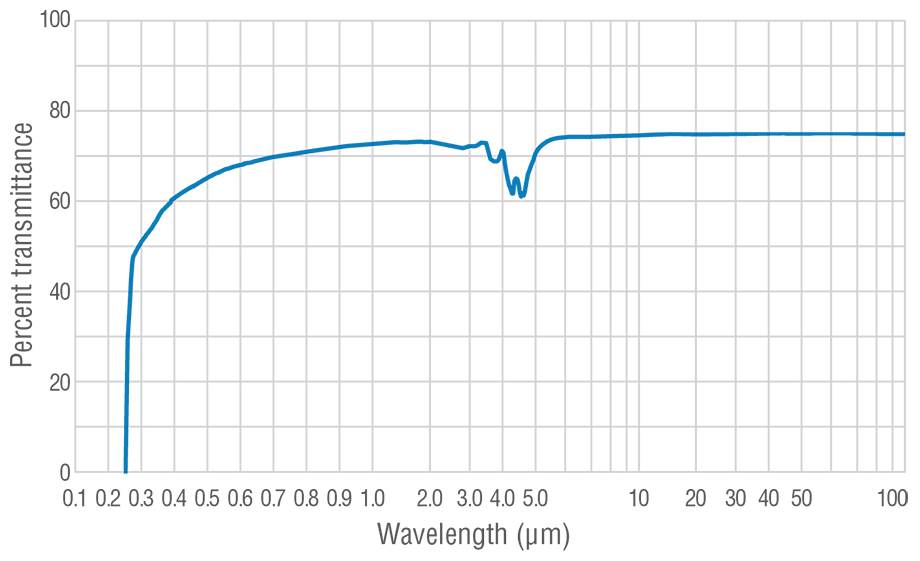 Diamond
has excellent broad-range transmission from ultraviolet to far-infrared. Lake Shore uses synthetic (CVD-grown) diamond, typically in a small diameter, for cost reduction. Diamond is very strong, and a thin window may be used for both room
temperature and cold windows. Diamond is a crystalline material, so care must be taken if the application is sensitive to birefringence.
Diamond
has excellent broad-range transmission from ultraviolet to far-infrared. Lake Shore uses synthetic (CVD-grown) diamond, typically in a small diameter, for cost reduction. Diamond is very strong, and a thin window may be used for both room
temperature and cold windows. Diamond is a crystalline material, so care must be taken if the application is sensitive to birefringence.
| Refractive index | 2.4 |
|---|---|
| Transparency range | 0.22 μm to >100 µm |
| Scratch resistant | |
| Cold window ✔ | |
Polyethylene
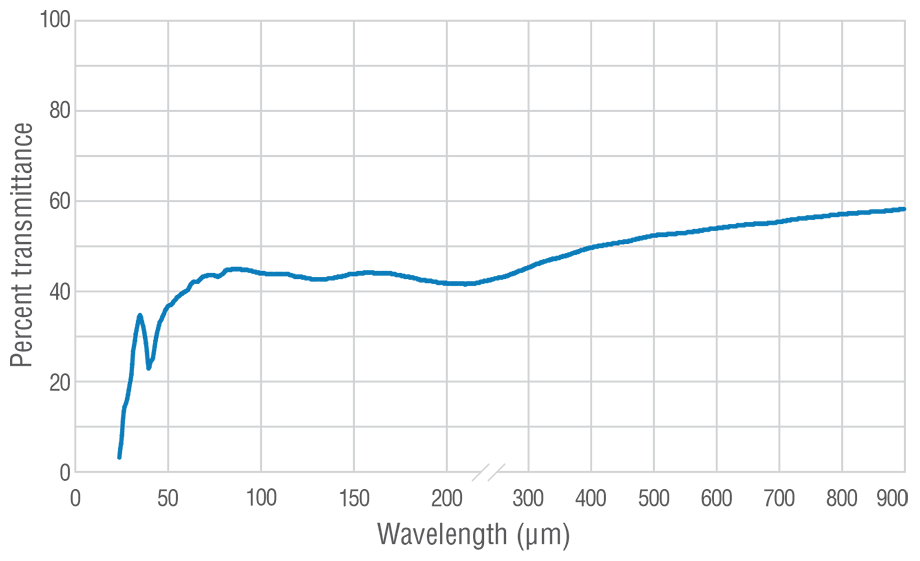 Polyethylene
(PE) is transparent in far-infrared. Many customers working in the infrared range choose to have two ZnSe windows and two PE windows on their cryostat to cover transmission from visible to far-infrared. PE is made in-house from commercially
available materials. Surface imperfections and scratches may be present but are usually smaller than the wavelength of IR light used with these windows. PE cannot be sealed cold, so it can only be used as a room-temperature window.
Polyethylene
(PE) is transparent in far-infrared. Many customers working in the infrared range choose to have two ZnSe windows and two PE windows on their cryostat to cover transmission from visible to far-infrared. PE is made in-house from commercially
available materials. Surface imperfections and scratches may be present but are usually smaller than the wavelength of IR light used with these windows. PE cannot be sealed cold, so it can only be used as a room-temperature window.
| Refractive index | 1.49 |
|---|---|
| Transparency range | 20 μm to >100 µm |
| Susceptible to scratching | |
| Cold window ✖ | |
Polypropylene
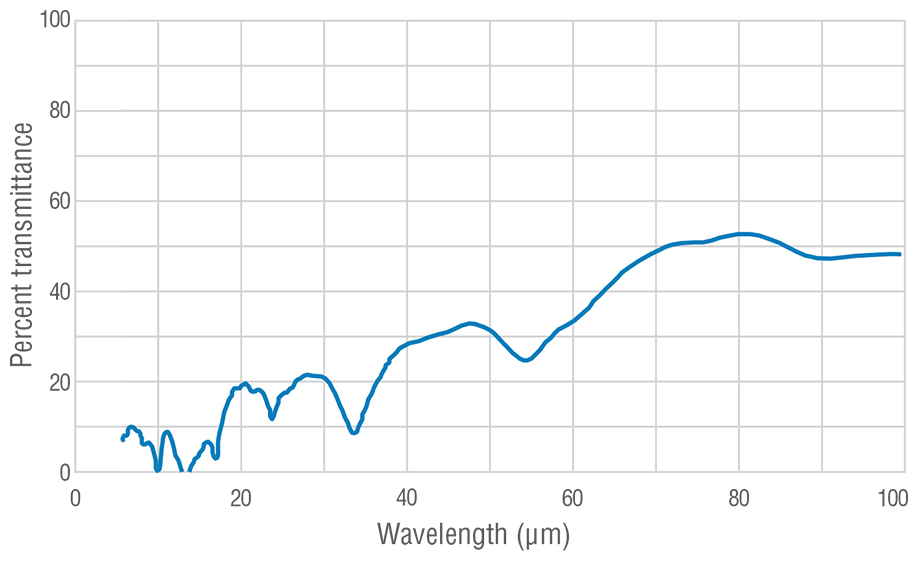 Polypropylene (PPN) is transparent in the far-infrared. While it does not have as good a transmission as PE, it may be used as a cold window. PPN is made in-house from commercially available materials. Surface imperfections and scratches may be present but are usually smaller than the wavelength of IR light used with these windows. Lake Shore commonly pairs PPN with PE on cryostats such as the STVP-FTIR, with PPN the cold window of the pair and PE the room-temperature window.
Polypropylene (PPN) is transparent in the far-infrared. While it does not have as good a transmission as PE, it may be used as a cold window. PPN is made in-house from commercially available materials. Surface imperfections and scratches may be present but are usually smaller than the wavelength of IR light used with these windows. Lake Shore commonly pairs PPN with PE on cryostats such as the STVP-FTIR, with PPN the cold window of the pair and PE the room-temperature window.
| Refractive index | 1.49 |
|---|---|
| Transparency range | 50 μm to >100 µm |
| Susceptible to scratching | |
| Cold window ✔ | |
Crystalline quartz
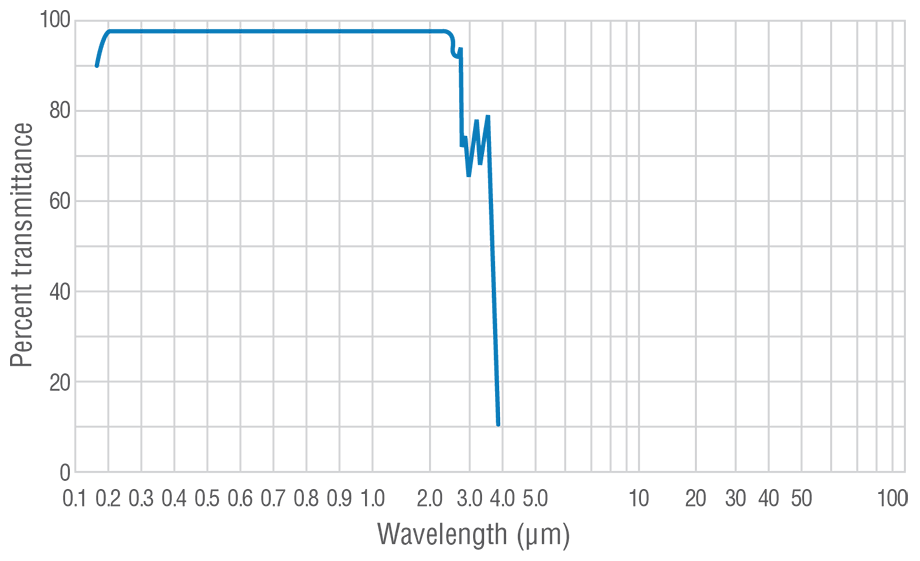 Crystalline quartz has a broad transmission range, extending from ultraviolet to near-infrared. It is opaque in the mid-infrared but opens up again in the far-infrared. It has better transmission in the far-infrared than sapphire, but since it is a crystalline material, care must be taken if the application is sensitive to birefringence. Crystalline quartz may be used on both cold and room-temperature windows.
Crystalline quartz has a broad transmission range, extending from ultraviolet to near-infrared. It is opaque in the mid-infrared but opens up again in the far-infrared. It has better transmission in the far-infrared than sapphire, but since it is a crystalline material, care must be taken if the application is sensitive to birefringence. Crystalline quartz may be used on both cold and room-temperature windows.
| Refractive index | 1.55 |
|---|---|
| Transparency range | 0.18 μm to 3.5 µm and >40 µm |
| Scratch resistant | |
| Cold window ✔ | |
Kapton
Kapton is an opaque plastic film that can be used for both cold and room-temperature windows. Kapton is commonly used on cryostats for x-ray measurements.
| Refractive index | 1.82 |
|---|---|
| Transparency range | X-ray |
| Cold window ✔ | |
Mylar
Mylar is an opaque plastic film that can be used for both cold and room-temperature windows. Mylar is commonly used on cryostats for Mössbauer spectroscopy. Care must be taken when this material is used as a cold window, as it is permeable to helium at temperatures above ~100 K.
| Refractive index | 1.64 |
|---|---|
| Transparency range | Gamma rays, and >200 µm |
| Cold window ✔ | |



